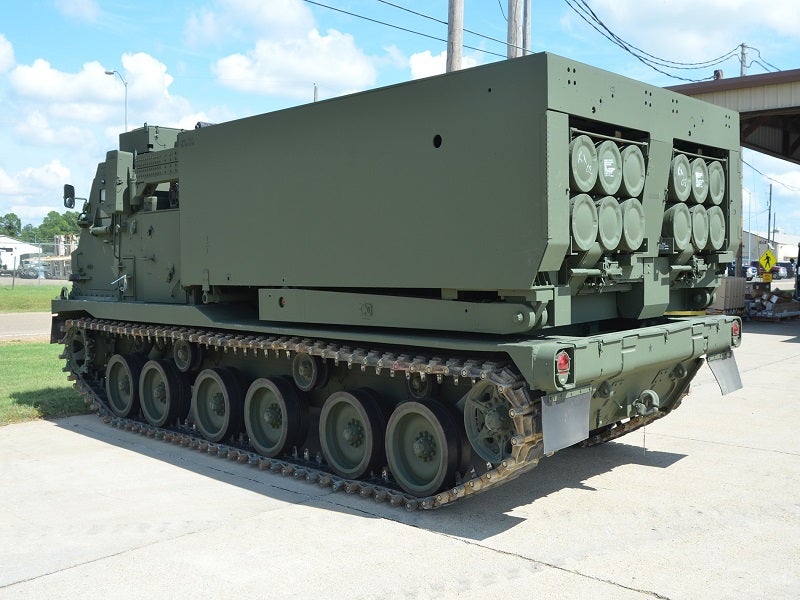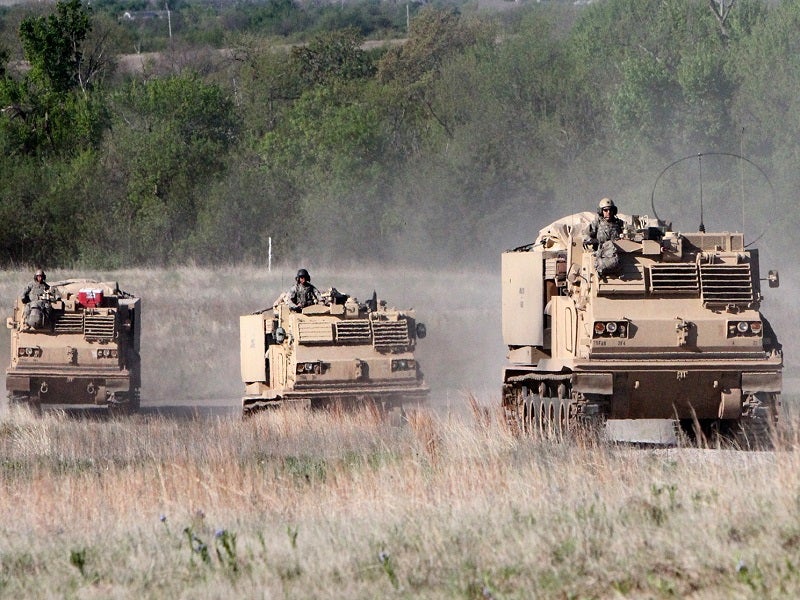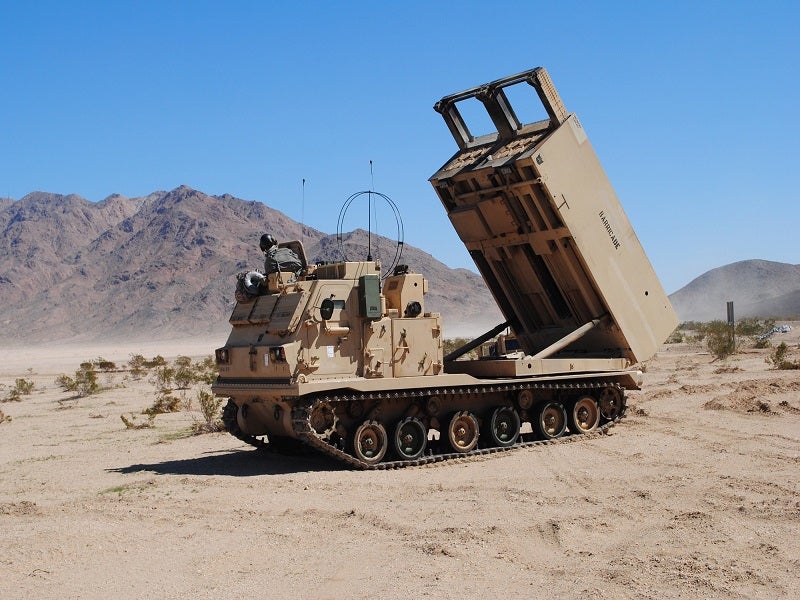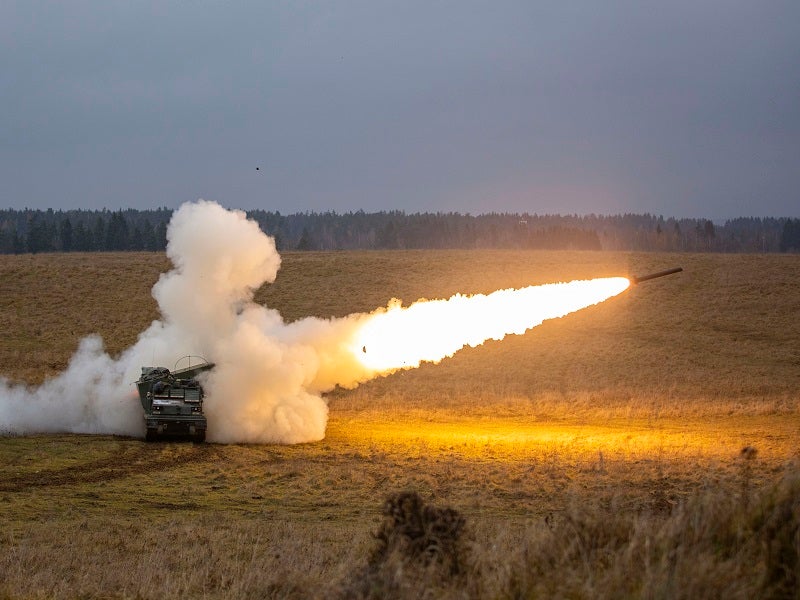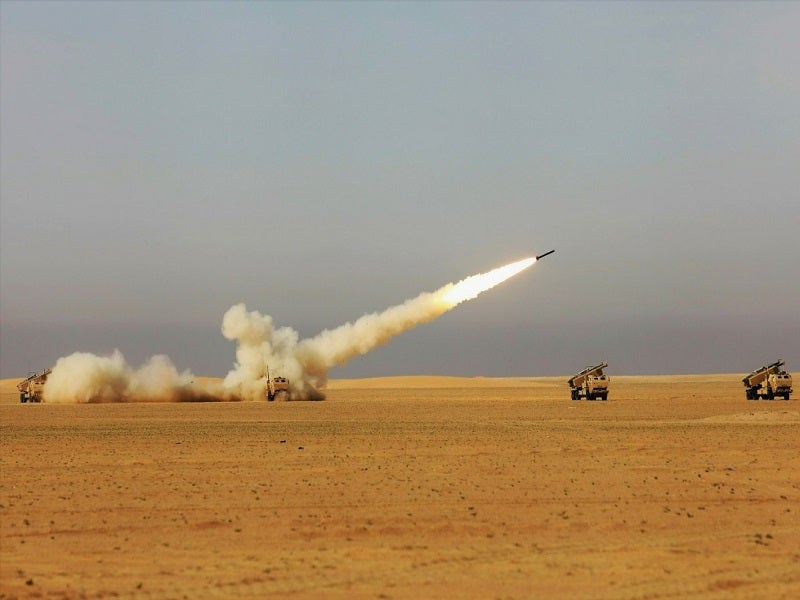The combat-proven M270 multiple launch rocket system (MLRS) is a highly mobile rocket artillery system manufactured in the US by Lockheed Martin Missiles and Fire Control, a subsidiary of Lockheed Martin. The MLRS is operational with the armed forces of Bahrain, Finland, Egypt, France, Germany, Greece, Israel, Italy, Saudi Arabia, Japan, South Korea, Turkey, the US and the UK. The system is built in Europe by an international consortium of companies from France, Germany, Italy and the UK.
The MLRS took part in a firing test campaign, as part of the upgrade to the European fire control system (EFCS), in December 2022. The test campaign was conducted by the NATO Support and Procurement Agency (NSPA) on behalf of France and Germany.
Following the invasion of Ukraine by Russia in February 2022, the UK Government announced in June 2022 that it would supply MLRS units to Ukraine to support it in the conflict with Russia. It decided to enhance the support by sending additional MLRS to Ukraine in August 2022.
The US announced that it would donate four M142 High Mobility Artillery Rocket Systems (HIMARS) and guided MLRS (GMLRS) munitions to Ukraine in June 2022, while Germany donated three M270 Mittleres Artillerie Raketen System (MARS) launchers and GMLRS ammunition from the Bundeswehr inventory.
The US Army received the first MLRS M270A2 launcher, a modernised version of the M270 MLRS, from Lockheed Martin during a ceremony at the Precision Fires Center of Excellence in Camden, Arkansas, in July 2022.
M270 MLRS orders and deliveries
In January 2006, two batteries of MLRS (nine launchers a battery) were agreed to be transferred from the Netherlands to Finland. The systems were delivered in February 2007.
An MLRS was deployed in support of Operation Iraqi Freedom in 2003. The US Army fielded the upgraded M270A1 launchers and new army tactical missile system (ATACMS) quick reaction unitary missile in February 2011, placing a $22.1m order for M270 launcher upgrade kits.
The Finnish Army placed a $45.3m order to upgrade its 22 M270 MLRS launchers in May 2011. The upgrade incorporated the universal fire control system in the MLRS, allowing the launchers to fire precision global positioning system (GPS)-guided munitions.
Lockheed Martin received a $362m contract from the US Army to recapitalise 50 MLRS launchers to the latest configuration (M270A2) in April 2019. The US Army has plans to upgrade 225 M270A1 launchers and 160 decommissioned M270A0s to the M270A2 standard. The upgrade is expected to extend the life of the MLRS launchers until 2050.
The company secured another contract, worth $226m, to refurbish 44 additional M270s in June 2020. The US Department of Defense (DoD) awarded a contract modification worth $214.7m to Lockheed Martin Missiles and Fire Control to continue the modernisation of the M270 MLRS to M270A2 in April 2021.
In April 2022, another contract modification, worth $224m, was awarded by the DOD to the company to recapitalise the MLRS into the M270A2 configuration.
The British Army announced a five-year programme to upgrade its existing fleet of 44 M270 MLRS launchers in April 2021, following an agreement with the US DoD. The upgrade will add an armoured cab, as well as modernised automotive and launcher components.
Furthermore, the UK will develop country-specific components for the new launchers, including composite rubber tracks, and a vehicle camera and radar system. It will also work on the development of a new fire control system in partnership with the US, Finland and Italy.
M270 MLRS design and features
The MLRS is a high-mobility automatic system based on an M270 weapons platform. The MLRS fires surface-to-surface rockets and the ATACMS. Without leaving the cab, the crew of three (driver, gunner and section chief) can fire up to 12 MLRS rockets in less than 60 seconds.
The MLRS launcher unit comprises an M270 launcher loaded with 12 rockets, packaged in two six-rocket pods. The launcher, which is mounted on a stretched Bradley chassis, is a highly automated self-loading and self-aiming system. It contains a fire control computer that integrates the vehicle and rocket-launching operations.
The rockets can either be fired individually or in ripples of two to 12. Accuracy is maintained in all firing modes by the computer re-aiming the launcher between rounds.
The M270 MLRS can be readily transported to areas of operations, for example by the C-5 transporter aircraft or train. The MLRS offers optimal cross-country mobility and a road speed of 64km/h.
Multiple launch rocket system tactical rocket warhead and munitions
The basic MLRS tactical rocket warhead contains 644 M77 munitions, which are dispensed above the target in mid-air. The dual-purpose bomblets are armed during freefall, and a simple drag ribbon orients the bomblets for impact. Each MLRS launcher can deliver approximately 8,000 munitions in less than 60 seconds at ranges exceeding 32km.
Other mission-oriented rockets include the extended-range (ER) rocket, the reduced-range practice rocket (RRPR), which has a range of 8km to 15km, and the AT2, which dispenses 28 antitank mines a round. The ER rocket was first fielded in 1998 and carries 518 improved munitions in excess of 45km.
M270 MLRS fire control
The MLRS computerised fire control system enables a reduced crew, or even a single soldier, to load and unload the launcher. A portable boom control device and cable hook assembly are used for loading and unloading. The fire control computer allows firing missions to be carried out either manually or automatically.
In a typical fire mission, a command post transmits the selected target data directly to the MLRS computer.
The computer aims the launcher and prompts the crew to arm and fire a pre-selected number of rounds. Multiple mission sequences can be pre-programmed and stored in the computer.
ATACMS (army tactical missile system) details
MLRS also fires the long-range Lockheed Martin ATACMS-guided missiles. The ATACMS family includes the block 1, block 1A and block 1A unitary missiles, as well as the M57E1 ATACMS modification. Block 1, which was used during Operation Desert Storm, carries 950 baseball-sized M74 submunitions to ranges exceeding 165km.
The block 1A missile extends the range to more than 300km by reducing the submunition payload and adding GPS guidance. The block 1A unitary missile, which has a single-burst warhead, was first deployed in support of Operation Iraqi Freedom in March/April 2003. The M57E1 ATACMS MOD missile is equipped with inertial measurement unit and GPS guidance to engage point and area targets 300km away.
Lockheed Martin was awarded the first US Army contract for the production of the unitary missile in February 2004. This was followed by a second contract for 50 missiles in January 2005.
The programme to develop the block II missile, with GPS and 13 BAT (brilliant anti-tank) submissiles, and Block IIA missile, with six improved BAT submissiles, was cancelled in February 2003. The BAT submunition, manufactured by Northrop Grumman, is an unpowered glider, which has acoustic sensors for target detection and infrared sensors for terminal guidance. Its maximum range is 140km.
Guided multiple launch rocket system (GMLRS) details
Lockheed Martin developed a new ER GMLRS with a range of more than 70km. The GMLRS XM30 rocket has a GPS and inertial guidance package, as well as small canards on the rocket’s nose to enhance accuracy.
GMLRS completed system development and demonstration (SDD) tests in December 2002 and entered low-rate initial production (LRIP) in April 2003. A total of 156 GMLRS rockets were produced under the LRIP I contract with deliveries completed in May 2005. Meanwhile, 840 rockets were produced under the LRIP II contract, awarded in March 2004, and 1,014 under the LRIP III contract, awarded in February 2005.
Initial operational capability (IOC) was achieved in 2006, but the system has been operationally deployed since September 2005 in Iraq. The GMLRS is an international programme involving the UK, Italy, France and Germany, as well as the US. The industrial team includes Diehl, MBDA, and FiatAvio.
The production milestone of the 50,000th GMLRS rocket was achieved in January 2021.
The three variants of GMLRS are Unitary, Alternative Warhead, and Extended-Range guided multiple launch rocket system (ER GMLRS). The next-generation ER GMLRS munition was successfully flight-tested from the US Army’s HIMARS launcher at White Sands Missile Range, New Mexico, in March 2021. Deployable by HIMARS and the MLRS M270 family of launchers, the ER GMLRS provides an increased range of up to 150km.
GMLRS orders and deliveries
In August 2005, the UK placed a contract for GMLRS, becoming the first international customer. GMLRS entered service with the UK Army Royal Artillery in April 2007 and began deployment to Afghanistan in June 2007.
The first deliveries of a unitary variant of GMLRS, with a single 81.6kg (180lb) warhead and range of up to 70km, were made in May 2005. Lockheed Martin was awarded an SDD contract for 86 unitary variant rockets in October 2003.
The programme was accelerated following a US Army ‘urgent need’ statement in January 2005. The first 72 GMLRS unitary rockets were delivered in June of that year. Lockheed Martin conducted 17 tests on the unitary variant in 2006. GMLRS unitary entered LRIP in June 2007. Operational testing was completed in April 2008. A follow-on contract was awarded in August 2008. Lockheed Martin was awarded a $512m contract to supply GMLRS and HIMARS launchers to the US Army and US Marine Corps, in January 2008.
The US Army placed a $603m order for GMLRS and HIMARS launchers in February 2009. Lockheed Martin delivered the 10,000th GMLRS to the US Army in April 2010.
Lockheed Martin was awarded a $445m follow-on contract by the US Army for 735 GMLRS unitary rocket pods and 508 RRPR pods in June 2011. The US DoD placed a $79.4m order for the development of a new GMLRS variant with a new warhead in April 2012.
In July 2012, the US Army placed a $353.2m order for the seventh production lot of GMLRS unitary rockets. The 20,000th GMLRS unitary rocket was delivered to the US Army in August 2012.
Lockheed Martin was awarded a $197m contract option by the US Army in January 2013, bringing the GMLRS production lot seven contract value to $550.8m.
The company received a $331m contract from the US Army for the 11th production lot of GMLRS rockets in June 2016.
Lockheed Martin secured a $471m contract from the US Army for the 12th production lot of GMLRS rockets in July 2017, followed by a contract worth $828m for the 13th production lot in May 2018.
Lockheed Martin was awarded a $1.13bn contract for the 14th production lot of GMLRS rockets and associated equipment in March 2019. A contract worth $1.12bn for the 16th production lot, covering the production of more than 9,000 GMLRS unitary and alternative-warhead rockets and 2,000 low-cost RRPRs, was awarded to the company in March 2021.
The company received contract options totalling $520.8m in value from the US Army in October and November 2022 to provide GMLRS. The procurement of GMLRS is intended to replenish the GMLRS supplied to Ukraine from the DoD inventory.
M270A1 upgrade
In December 2000, an LRIP contract was placed with Lockheed Martin for 66 upgraded M270A1 launchers for delivery by 2004. MLRS launchers upgraded to M270A1 status have improved fire control systems (IFCS) and improved launcher mechanical systems (ILMS).
The M270A1 launcher completed operational testing in October 2001 and was first fielded in May 2002. Lockheed Martin also received a foreign military sales (FMS) contract for the new launchers from the Republic of Korea.
The IFCS provides additional capacity to accommodate complex munitions and modern computer electronics, including video display, on-board navigation with GPS, architecture for ultrafast signal processing, and advanced mission software. The ILMS reduces the time to aim the launcher to 16 seconds (compared to 93 seconds). The reloading time is cut from four to three minutes.
UK systems also received the IFCS. The first 15 systems for the UK were ordered in March 2005 for delivery by the end of 2006. Italian, German and French MLRS feature the EFCS developed by EADS and Dornier.
The M20A2 upgrade
The M20A2 configuration will have a zero-time launcher, new 600hp engine and improved armoured cab. The new common fire control system (CFCS) integrated into the M20A2 provides commonality with the HIMARS and the future MLRS family of munitions (MFOM).
The improved cabs increase the interior volume significantly, while the seats are designed with energy-absorbing capability to protect the occupants from mine blasts and improvised explosive devices (IEDs). The fire control panel of the MLRS has also been upgraded.
The M20A2 systems will be able to fire 12 GMLRS or ER GMLRS rockets, four precision strike missiles (PrSM) or two ATACMS.

